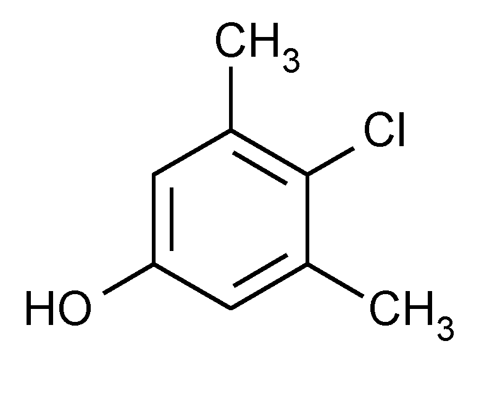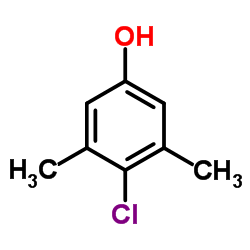Formula C8H9OCl | CAS ID 88-04-0 | |
Chloroxylenol my favourite molecule
Chloroxylenol, also known as para-chloro-meta-xylenol (PCMX), is an antiseptic and disinfectant which is used for skin disinfection and cleaning surgical instruments. It is also used within a number of household disinfectants and wound cleaner. It is less effective than some other avaliable agents. It is available as a liquid.
Contents
- Chloroxylenol my favourite molecule
- What does chloroxylenol mean
- Uses
- Side effects
- Humans
- Animals
- Society and culture
- References

Side effects are generally few but can include skin irritation. It may be used mixed with water or alcohol. Chloroxylenol is most effective against gram-positive bacteria. It works by disruption of the cell wall and stopping the function of enzymes.

Chloroxylenol was first made in 1927. It is on the World Health Organization's List of Essential Medicines, the most effective and safe medicines needed in a health system. The wholesale cost in the developing world is about 2.00 to 6.20 USD per liter of 5% solution. It is sold in a number of formulations and under a number of brand names including Dettol.

What does chloroxylenol mean
Uses
It is used in hospitals and households for disinfection and sanitation. It is also commonly used in antibacterial soaps, wound-cleansing applications and household antiseptics such as Dettol liquid (to which it contributes its distinctive odor), cream and ointments.
Side effects
Chloroxylenol is not significantly toxic to humans, is practically non-toxic to birds, and is moderately toxic to freshwater invertebrates. It is highly toxic to fish and cats and should not be used around them. It is a mild skin irritant and may trigger allergic reactions in some individuals.
Humans
Chloroxylenol has the potential for causing lethal toxicity. It is poisonous when swollowed and even when it is unintentionally breathed in.
In a case report, a 42-year-old British man died from Dettol overexposure in May 2007. He had "obsessive cleaning disorder" and used to keep buckets of dettol around his flat with rooms littered with dettol. The autopsy was not able to conclude whether the lethal exposure to Dettol was via ingestion or inhalation. A medical study which analyzed 177 cases of Dettol intoxications via ingestion in Hong Kong concluded that ″Dettol poisoning resulted in serious complications in 7% of patients, including death".
Animals
Dettol is toxic to many animals, especially cats. Phenols are of particular concern because cats are unable to eliminate the toxins following ingestion. A cat may swallow the product by licking its paws after they have come into contact with it.
In Australia, Dettol spray has been shown to be lethal to cane toads, an invasive species that was introduced from Hawaii as a result of bad judgment in 1935. It had been hoped that the amphibian would control the cane beetle but it became highly destructive within the ecosystem. Spraying the disinfectant at close range has been shown to cause rapid death to toads. It is not known whether the toxins are persistent or whether they harm other Australian flora and fauna.
Owing to concerns over potential harm to other Australian wildlife species, the use of Dettol as an agent for pest control was banned in Western Australia by the Department of Environment and Conservation in 2011.
Society and culture
A number of brand names are avaliable.
The active ingredient in Dettol that confers its antiseptic property is chloroxylenol (C8H9ClO), an aromatic chemical compound. Chloroxylenol comprises 4.8% of Dettol's total admixture, with the rest made up by pine oil, isopropanol, castor oil, soap and water.
